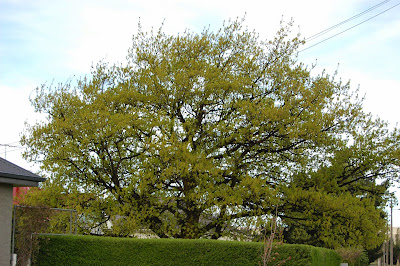As I promised recently, here is another in the series of contributions I have been writing for the Otago Rose Society's monthly newsletter.
With an
Ashes cricket series in progress, this tale of two cricketers, one an
Australian and the other an Englishman, is topical, albeit that only the
Australian was an international player of renown while his English counterpart,
born 96 years earlier, was but an enthusiastic village cricketer.
The
Englishman, Joseph Hardwick Pemberton, was born into a well-to-do family in
1852, and lived his entire life of 73 years in his ancestral family home in the
village of Havering-atte-Bower, Essex. His happy childhood days were reportedly
made even happier by playing in the large garden with informal winding paths
overgrown with shrubs and punctuated by numerous old roses grown by his
grandmother. It was there that young
Joseph’s love of roses germinated, and even as a small child he insisted on
wearing a rose bloom in his buttonhole when he attended church with his family.
As a young
man Pemberton studied theology, became a curate and was eventually the inaugural
priest of the Church of Ascension at nearby Romford. In his spare time, he
followed a variety of interests in addition to cricket. He was a breeder of
horses, but it was his love of roses that led to his lifelong hobby of
exhibiting and eventually breeding the loveliest of all garden plants.
At the age
of 22, Reverend Pemberton began exhibiting roses from the long established
garden at the family home, which by that time was occupied only by himself and
his sister Florence, five years his junior. Neither Joseph nor Florence ever
married and they lived together there until Joseph’s death in 1926. Florence
soon became as immersed in exhibiting roses as was her brother and they were inseparable
joint exhibitors at rose shows for many years.
It was
almost inevitable that Pemberton would eventually dabble in breeding roses.
When he emerged onto the scene as a breeder, however, it wasn’t with the aim of
producing exhibition blooms. His aim was to establish robust varieties which
would bloom for long periods while retaining the charm of the old roses in the
Pemberton garden. As the foundation stock for his breeding line, Joseph chose a
shrubby rose ‘Trier’ from a German breeder, Herr Peter Lambert. By introducing
carefully selected elements from roses in his late grandmother’s collection,
Rev Pemberton gave birth to a unique grouping of roses which were later
classified by leading rosarians of the day as Hybrid Musk roses. Pemberton, who
became a nurseryman on his retirement from the clergy at age 60, himself
adopted the term ‘Hybrid Musk’ soon after.
Following
Joseph’s death in 1926, the nursery continued under the management of Florence
Pemberton and in total, the Pemberton nursery introduced close to fifty new
varieties, two of their early successes being Hybrid Musk roses ‘Pax’ and
‘Moonlight’. Another popular creation
was ‘Pemberton’s White Rambler’. ‘Robin Hood’, introduced the year following
Joseph’s death, became a parent of numerous Kordes roses, including ‘Iceberg’.
And so to
the Australian cricketer, Max Walker. Following Walker’s retirement from an
illustrious test cricketing career, he became a popular author and a pioneer of
the after-dinner speaking circuit. He was (and still is) a larger-than-life
character and a wonderful storyteller. When asked how one person could possibly
have witnessed so many outrageously hilarious incidents in a relatively short
period as an international sportsman, Walker replied “I never let the truth
stand in the way of a good story”.
An English
rose nursery’s website advertises three of Rev Pemberton’s roses as “The
Vicar’s Daughters Collection”, claiming ‘Penelope’, ‘Cornelia’ and ‘Felicia’
were named after Joseph Pemberton’s daughters. Did the nursery’s marketing guru
follow Max Walker’s example, or could it be that the bachelor vicar had a dark
secret?



